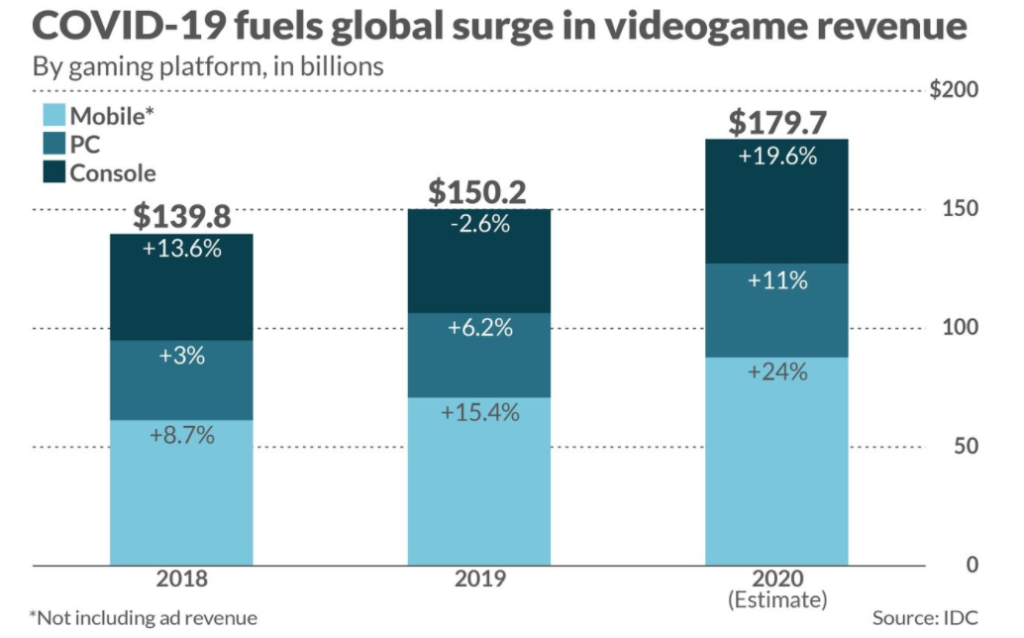At the time of writing this article in Jun 2021, the video gaming market was estimated at $208billion in 2020. The gaming industry is expected to further growing at 5% CAGR over the next 4 years.

The proliferation of video gaming over the past several decades has vindicated the wide emergence of a social trend that used to be considered a niche past-time activity. I remember when I grew up in the 1990s, playing video games was seen in every way as “child’s play”. Sure even the “cool kids” played video games from time to time, but for the most part, the prevailing sentiment at the time was that video games…. are what kids played … when they are bored… or had no friends…
Fast forward to the present day… Video games are becoming a goliath of an industry rivaling every other form of entertainment. Apparently, in 2020, the video games have become bigger than the global movie and North American sports entertainment industries COMBINED. https://www.marketwatch.com/story/videogames-are-a-bigger-industry-than-sports-and-movies-combined-thanks-to-the-pandemic-11608654990. In 2020, global video gaming sales surged 20%, generating over $180 billion in sales. Meanwhile, global film and north american sports industry generated $100 billion and $75 billion in sales respectively. The eclipse of video gaming over sports and movies is of course in large part enabled by the decline of traditional entertainment endeavors plus the circumstantial boost to demand for video games… Nonetheless, I find it still quite unexpected that video gaming – something of a guilty pleasure of mine when I was growing up – would formidably rival traditional entertainment industries… maybe the nerds and geeks are finally taking over…

What’s the point in talking about all of this? Well, the interesting implication to note from the cementing presence of video games industry is that I think that the burgeoning growth of this industry is probably just taking off; and there remains plenty of running room. Even with annual growth of double digits over the past 20 years, this is still by no means a mature industry, so it makes sense to pay close attention to this segment of the market, which used to be easily overlooked by investors with also probably a dismissive chuckle…
There are a few growth vectors propelling the continued rise of video gaming. First, ease of access/distribution. In the old days, video games are sold only on some form of physical storage devices, usually in CDs, or floppy disks (some people reading this may not know what those are). This form of selling also requires physical brick & mortar stores for distribution. The cost of production and distribution translated into higher MSRP, along with the need to physically obtain video games, amounted to impediments to video game sales. Nowadays, these former issues no longer constitute much problem as most games are sold virtually on digital stores, accessible by your phone, computer or gaming console’s online stores… The ease of distribution reduced cost of selling, translating into lower prices for many games, and users are much more likely to buy games when all such required is a simple click or two rather than driving to some location to purchase physical games. This ease of access/distribution should continue to drive gaming demand. Second, I would expect contents and sophistication continue to increase as better electronic technology evolve. We are moving toward a digitalized and electronified age. The future is largely on the internet, and probably augment/virtual reality… It is also conceivable that more inventions and life experiences will be spent online than in real life… which is sad, scary and also offering a smorgasbord of novel opportunities… This new age will probably offer more online/electronic forms of entertainment… and video gaming will be a big part of this new age… Lastly, the social stigma of video games are dissipating… a 50 year old gamer in 1990s would be something of an outlier, but 20 years from now, a 50 years old gamer (whether casual or more hardcore) would probably be fairly common. This can be mostly attributed to the different technologies accessed by people when they were young. 40 years ago, the 1980s offered a dearth of gaming experiences. Yet the average 10 year old child will have no shortage of video games to turn to… and habits/activities picked up when young are often retain to older ages, so gaming industry will have an even wider age spectrum for its participants… and a greater % of global population will be gamers. There are ~2 billion people who play video games in the world today… It would be unsurprising if this figure doubles in the next 20 years as a result of increasing number of people growing up in a generation where video gaming is easily accessible and becomes captivating…
So videogaming… it’s just getting started. Pay attention to this industry. It might just make you rich…
How do you invest in videogaming? Stay tuned. I got a few things that are interesting.


